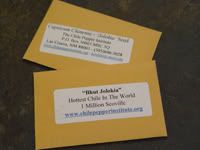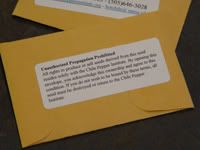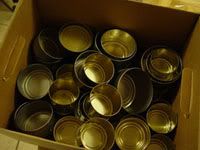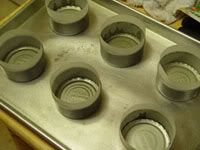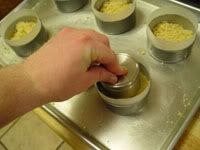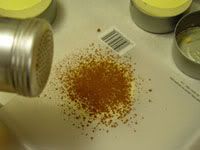I got a wild hair the other day and decided to play with puff pastry. I already had strawberries in the freezer, fresh from our landlord's parents' garden up in Montana, or so I've been told. So I decided to make some strawberry turnovers.
I didn't want to just have strawberries in the middle. I wanted something a little closer to strawberry pie filling, without actually tasting like the atomic red bags and cans of sugary, not-quite-strawberry-tasting awfulness at the grocery story. I started with a half cup of orange juice (yes, I still measure liquids by volume) and five ounces (by weight) of frozen strawberries. I added a tablespoon of agave syrup (hey, I was experimenting) and brought this mixture to a simmer in a small saucepan. When the strawberries had softened enough, I pureed them with an immersion blender.
I then added another fifteen ounces, by weight, of strawberries and let it simmer another couple of minutes, until all the strawberries had started to soften. This mixture was strained, and the juice was reserved in one container, and the whole strawberries in another. Both were placed in the fridge to cool. I don't know what I'm going to end up doing with the liquid, but I'm sure I'll find something. Maybe I'll just drink it. When the strawberry mixture had cooled, I mixed in three ounces, by weight, of shortbread cookie crumbs leftover from my most recent cheesecake venture.
The puff pastry I buy comes as two frozen tri-fold squares. I let it thaw, and then I rolled it out into somewhat flatter, but larger squares. I cut each of those into quarters, leaving me with eight squares. Two adjacent sides of each square were brushed with egg wash (a beaten egg plus a tablespoon of water). The strawberry mixture was divided across the eight sqaures, which were then folded over into triangles. Make sure the corner without any egg wash is folded onto the one with egg wash, and be careful to make sure the filling isn't oozing out the sides.
With a fork, I crimped the sides that were glued together, and then I used a sharp paring knife to slice two slits into the top of each pastry. I brushed eggwash over the top of each one, and then sprinkled with sugar. If I'd had access to coarse sugar, I would have used it, but since I didn't, I used regular old white sugar.
I could only fit six pastries onto one parchment-lined sheet pan, so I put the last two on another pan and set it in the fridge to chill until it was ready. The rest were baked at 400F for about fifteen minutes, or until golden, brown and delicious. When they came out, I baked off the last two. As soon as the turnovers were out of the oven, I slid them off of the baking pan onto a cooling rack to rest, and when they were cool, I plated them.
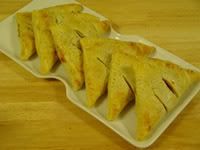
Notes: This wasn't a perfect recipe. My wife claimed to love them, but I thought the filling was kind of pasty. The cookie crumbs were supposed to keep the strawberries from leaking all over, but I think I added too many of them. Maybe next time I'll cut that amount in half and see how it goes. I've also thought about adding in a slurry of tapioca starch after liquifying the first part of the strawberries, and then bringing it to a boil to thicken before adding the other strawberries. Also, the mixture was a little tart. I will probably try real sugar next time. Also, I think I might have underbaked the turnovers. They tasted a little doughey when I tried a warm one, but were just fine when cooled. Despite my complaints, I think they still turned out pretty nice.
